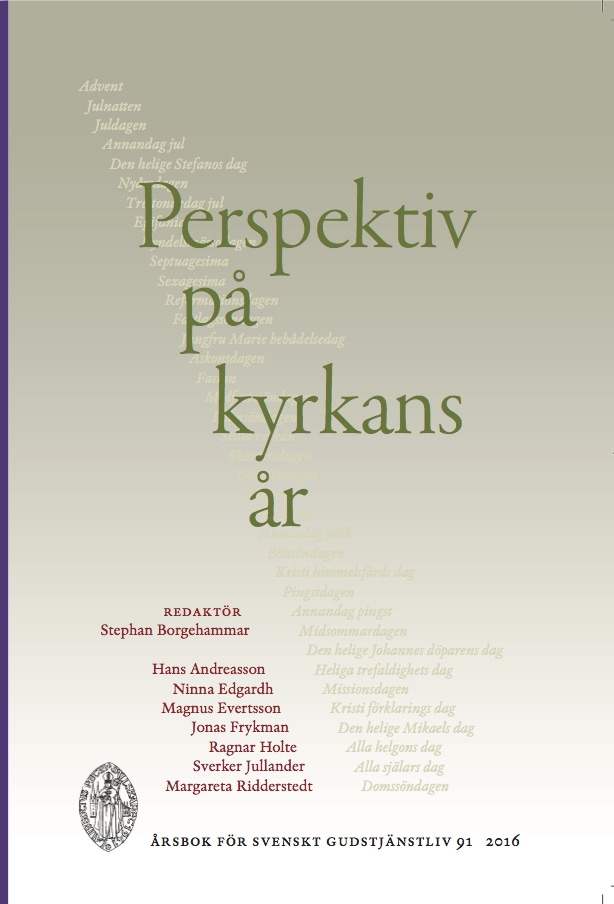Kyrkoårsfirande och evangeliebok
Abstract
Liturgical Year and Lectionary
An established lectionary and a liturgical year both exercise considerable influence upon worship. The main purpose of this article is to highlight some aspects of the interplay between the celebration of the liturgical year and the use of specific texts in the Church of Sweden in recent decades.
The lectionary in the Church of Sweden has medieval roots. In the nineteenth century, the annual cycle of epistles and gospels was supplemented by two complete series of texts on which the sermon should be based, so that over a period of three years a greater number of pericopes would be commented on from the pulpit. The lectionary of 1983 introduced three complete cycles of Old Testament texts, epistles and gospels. The lectionary of 2002 revised the selection in an attempt to clarify the interplay between Old and New Testament pericopes; it also strove to make the language and choice of texts more gender inclusive and to provide more texts from the Psalter. Other minor changes were introduced, too, partly with an eye to revisions in the Roman Catholic and German Evangelical- Lutheran lectionaries. However, the Revised Common Lectionary was not adopted.
Collisions between mobile celebrations and celebrations on a fixed date have always been a feature of the liturgical year. In the liturgical year of the Church of Sweden, the following feasts are always celebrated on a Sunday, thus defeating the theme and pericopes of the Sunday they happen to collide with: Purification of Mary (a Sunday near 2 Feb.), Annunciation of Mary (a Sunday 22–28 March, or earlier if this would collide with Palm Sunday or Easter), John the Baptist’s Day (a Sunday 21–27 June), St. Michael’s Day (a Sunday 29 Sept.–5 Oct.), Thanksgiving Day (2nd Sunday of Oct.) and All Souls’ Day (1st Sunday of Nov.). A table shows how many times various Sundays are defeated by these feasts during the years 1984–2016.
All Souls’ Day is a particular case. It originated in relation to All Saints’ Day, which in Sweden since 1953 is always celebrated on the Saturday 31 Oct.–6 Nov. The following Sunday thus became ”The Sunday after All Saints” and assumed a function similar to All Souls in other churches, with a thematic focus on the departed.
Another particular case considered in the article is John the Baptist’s Day and the celebration of Midsummer. Since 1953, Midsummer Day is a Swedish public holiday that always falls on the Saturday occuring 20–26 June. Until 2002, the Church of Sweden used to celebrate John the Baptist’s Day on Midsummer Day, with pericopes that primarily envisaged the latter by focusing on creation. The lectionary of 2002 separates the two days, so that Midsummer Day (Saturday) has the theme ”Creation” while John the Baptist’s Day (Sunday) has the theme ”The Prophet of the Most High”. However, in the lectionary of 1983, Midsummer Day had the theme ”Creation and Salvation”, which is still reflected in the epistles for that day in the new lectionary. Another inconvenience is that John the Baptist’s Day tends to defeat those Sundays after Trinity when the gospel pericopes contain the well-known Lucan parables of the lost coin, the lost sheep and the prodigal son.
The article ends by pointing out some further problems of this kind, which will need to be considered when the time is ripe for a new revision of the lectionary.
Downloads
Publicerad
Nummer
Sektion
Licens
© författarna, Laurentius Petri Sällskapet för svenskt gudstjänstliv samt Artos & Norma bokförlag. Det är tillåtet att kopiera och använda material ur Svenskt Gudstjänstliv för forskningsändamål om källan anges. För övriga ändamål kontakta respektive artikelförfattare samt förlaget. Särskilda restriktioner kan gälla för bildmaterial.


